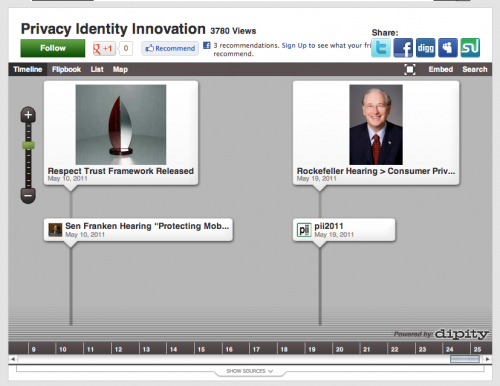You are here
Mapping a Controversy Using Dipity Timelines
Primary tabs

Screen shot of "Privacy Identity Innovation" timeline on Dipity
In this lesson, students created Dipity timelines that allow them to integrate multi-media content into a temporal-sequential order. Taking the sources from their first essay, students reflect on the benefits of the multimedia/chronological presentation.
research, revision, reflection, digital literacy
Dipity acccount, which is free online at Dipity.
Computer-assisted classroom.
In this lesson, students created Dipity timelines. These timelines allow students to integrate multi-media content into a temporal-sequential order. They can embed their product into websites and other online texts, much like you can embed a Youtube video. The interface is very easy, and the students were able to create timelines within 30 minutes. Students embedded their timelines into the course blog in Drupal (15 minutes). Students also wrote a blog entry (15-30 minutes) that analyzed the differences and benefits of using Dipity to map their controversy as compared to the 4-7 page research Essay 1.1 they had just completed.
I created a sample Dipity timeline and learned the Dipity interface. I also created instructions for how to embed a multi-media element into Drupal. Students also had already researched a controversy that they were able to map in the Dipity timeline.
Students had turned in the Essay 1.1 assignment for Rhetoric 306 at the University of Texas. This essay requires students to research a controversy and map the network of positions within a critical situation. Students already had a working knowledge of their controversy, and thus were able to create a multi-media timeline with links, images, and multi-media content about their controversy.
Today, we are going to be using the online interface Dipity to create a timeline of your controversy from Essay 1.1. For those of you with topics in common, you will be working in groups. For those of you with a unique topic, you will be work individually but will be paired with a neighbor to discuss as you go. Before creating your own Dipity timeline, please survey some of the timelines with your neighbor and discuss what you see.
Instructions for the map:
Please create your own account with Dipity; make sure to pay attention to whether your map is private or public, depending on your preference. As for the map itself, it needs to be connected to your controversy for Essay 1.1 You are free to add as many links and videos as you would like, creating a dynamic, interactive sense of your controversy.
Instructions for embedding into Drupal:
First, write your reflection in the blog using the WYSWIG as normal. Then, you can go to Dipity and copy the embed code. BEFORE you enter the embed code into the blog, you have to change the "Input Format," which is below the field where you are typing. You change the Input to HTML. Paste the embed code into the blog. Finally, hit publish. Just make sure not to go back and forth between input formats. It will mess up your embed code.
The assignment was graded on a basis of completion of the Dipity timeline and the completed blog entry. However, if I had graded it, I could have considered: the number of items on the timeline, the quality of their reflection on the learning experience with Dipity, and whether they followed instructions to embed the timeline into Drupal.
Students loved the assignment. They were engaged in watching Youtube videos, finding new articles and links, and discussing the Dipity interface with their classmates. Some students expressed that they wished they had done the Dipity assignment before Essay 1.1. They were able to complete the assignment in one day, which was incredibly satisfying. They also found new sources for their rewrite assignment (Essay 1.2). Finally, students commented that creating the map was in some ways superior to their written map of the controversy, since it appealed to the senses with visual and textual content. They said it helped them to understand the controversy better.
Things I would change: The timelines students created could have had more links and events, if we had given them time to gather links before class. If I did it again, I would have them come in with previously discovered internet media, or have them build the map over two days. Finally, I would introduce the Dipity assignment before Essay 1.1 to give students time to draw from the concepts and research for their first essay.
Rhetoric 306 is a course in argumentation that situates rhetoric as an art of civic discourse. It is designed to enhancestudents' ability to analyze the various positions held in any public debateand to advocate positions effectively. Students work in this course willhelp them advance the critical writing and reading needed to succeed in coursesfor their major and university degree.
-

- Log in to post comments

